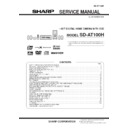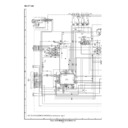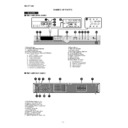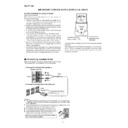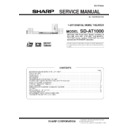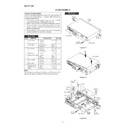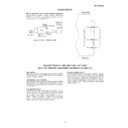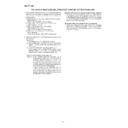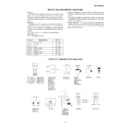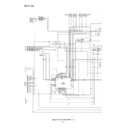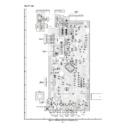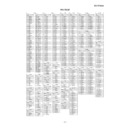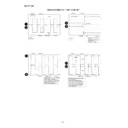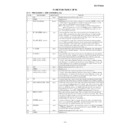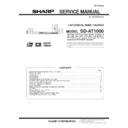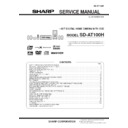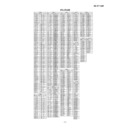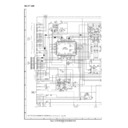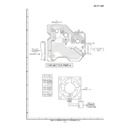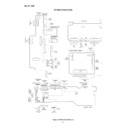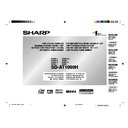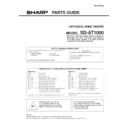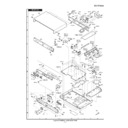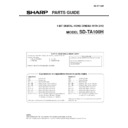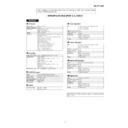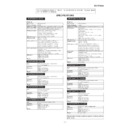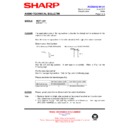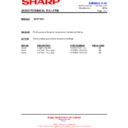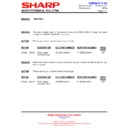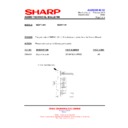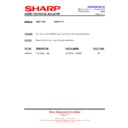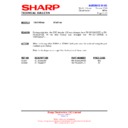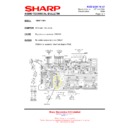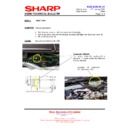Sharp SD-AT100 (serv.man2) Service Manual ▷ View online
– 33 –
SD-AT100H
DESCRIPTION OF AND HOW TO AVOID ERROR AND ABNORMALITY INDI-
CATIONS
CATIONS
Error
Cause
Preventive measure
NO DISC
• A disc is not loaded.
• The disc cannot be recognized due to scratches
• The disc cannot be recognized due to scratches
or dirt.
• The disc is loaded upside down.
Press the Open/Close key to open the cover and load a disc.
Clean the disc.
Load the disc in a proper direction.
Clean the disc.
Load the disc in a proper direction.
NO PLAY
• Unplayable disc
• The disc cannot be played correctly due to
• The disc cannot be played correctly due to
scratches or dirt.
• The disc does not satisfy the standards.
Load a playable disc.
Clean the disc.
Clean the disc.
READ err
• Unplayable disc
• Data cannot be read since the disc is scratched
• Data cannot be read since the disc is scratched
or dirty.
• The disc does not satisfy the standards.
Load a playable disc.
Clean the disc.
Clean the disc.
Er-CD01
• The pick position detection switch of CD/DVD
mechanism does not work (defective
mechanism).
mechanism).
Set the unit to the stand-by mode and turn it on again. If it does
not restore the unit, have it repaired at the dealer you purchased
it from.
not restore the unit, have it repaired at the dealer you purchased
it from.
Er-CD30
• The DVD unit and microcomputer do not
communicate properly.
• The DVD unit is defective.
• The unit is used where external noise is picked
• The unit is used where external noise is picked
up.
• The power supply picks up noise.
• Move the unit away from the noise source if located near.
• Use another AC outlet.
• Set the unit to the stand-by mode and turn it on again. If it does
• Use another AC outlet.
• Set the unit to the stand-by mode and turn it on again. If it does
not restore the unit, have it repaired at the dealer you purchased
it from.
it from.
DSP NG
DSP malfunction
• The unit is used where external noise is picked
• The unit is used where external noise is picked
up.
• The power supply picks up noise.
• Move the unit away from the noise source if located near.
• Use another AC outlet.
• Set the unit to the stand-by mode and turn it on again. If it does
• Use another AC outlet.
• Set the unit to the stand-by mode and turn it on again. If it does
not restore the unit, have it repaired by the dealer you
purchased it from.
purchased it from.
No Signal
• Signals are not sent to the external digital input
socket (optical).
• Signals input to the external digital input socket
(optical) have unplayable formats.
Check the connection and signals at the external digital input
socket (optical).
socket (optical).
TEMP
• The temperature of the power supply is too
high.
Before use, set the unit to the stand-by mode and wait for a
while.
If this occurs frequency, have it repaired by the dealer you
purchased it from.
while.
If this occurs frequency, have it repaired by the dealer you
purchased it from.
Er-AP02
Er-AP03
Amplifier is defective
(A/D reset monitor detects an error.)
(A/D reset monitor detects an error.)
Set the unit to the stand-by mode and turn it on again. If it does
not restore the unit, have it repaired by the dealer you purchased
it from.
not restore the unit, have it repaired by the dealer you purchased
it from.
Er-AP14
ICs of A/D and D/A converters cannot
communicate properly.
communicate properly.
• Move the unit away from the noise source if located near.
• Use another AC outlet.
• Set the unit to the stand-by mode and turn it on again. If it does
• Use another AC outlet.
• Set the unit to the stand-by mode and turn it on again. If it does
not restore the unit, have it repaired by the dealer you
purchased it from.
purchased it from.
SD-AT100H
– 34 –
DESCRIPTION OF CIRCUIT FOR 1-BIT UNIT
(SEE THE WIRING DIAGRAMS ON PAGES 86 AND 87.)
Input
Signals over certain level input from BIA106 are sliced into waveforms by RA173 (RA174), DA126, and DA127 (DA128, DA129).
The slice levels depend on the output of the unit.
In case of 25 W output setting, the level is set to gain distortion of approx. 10 % during output.
The level on the positive side is determined by RA175, RA177 and RA179 and that on the negative side by RA176, RA178, and
RA180, respectively.
After DC cut by CA108, the signals are input to AD conversion IC.
Signals over certain level input from BIA106 are sliced into waveforms by RA173 (RA174), DA126, and DA127 (DA128, DA129).
The slice levels depend on the output of the unit.
In case of 25 W output setting, the level is set to gain distortion of approx. 10 % during output.
The level on the positive side is determined by RA175, RA177 and RA179 and that on the negative side by RA176, RA178, and
RA180, respectively.
After DC cut by CA108, the signals are input to AD conversion IC.
modulation 1-bit conversion
The signals input to the AD conversion IC are converted into 1-bit signals for differential output.
For detailed technical description of 1-bit signal conversion, refer the technical manual for SM-SX100 already published.
The signals input to the AD conversion IC are converted into 1-bit signals for differential output.
For detailed technical description of 1-bit signal conversion, refer the technical manual for SM-SX100 already published.
Dead time and level shift
When the 1-bit signals are output from the AD conversion IC, the leading edge of the waveform is delayed for 20 to 25 nsec by
DA103 (DA102, DA101, and DA100), RA115 (RA114, RA113, and RA112), and CA155 (CA154, CA153, and CA152), compared
with the trailing edge.
As mentioned below, this operation is for reducing switching circuit loss in the final stage.
The signals are input to the buffer IC (AND gate IC) for the waveform format and are output.
Then the DC level is shifted by CA115 (CA114, CA113, and CA112), DA107 (DA106, DA105, and DA104) and RA120 (RA119,
RA118, and RA117). This is because the buffer IC operates between ground and + 5 V, while the next stage IC, gate driver (ICA101
to ICA 104), operates between the negative power source and + 9 V.
The shift quantity is output with amplitude of 5 V, based on the voltage raised by DA108 and DA109 from the bottom by approx.
2 V.
When the 1-bit signals are output from the AD conversion IC, the leading edge of the waveform is delayed for 20 to 25 nsec by
DA103 (DA102, DA101, and DA100), RA115 (RA114, RA113, and RA112), and CA155 (CA154, CA153, and CA152), compared
with the trailing edge.
As mentioned below, this operation is for reducing switching circuit loss in the final stage.
The signals are input to the buffer IC (AND gate IC) for the waveform format and are output.
Then the DC level is shifted by CA115 (CA114, CA113, and CA112), DA107 (DA106, DA105, and DA104) and RA120 (RA119,
RA118, and RA117). This is because the buffer IC operates between ground and + 5 V, while the next stage IC, gate driver (ICA101
to ICA 104), operates between the negative power source and + 9 V.
The shift quantity is output with amplitude of 5 V, based on the voltage raised by DA108 and DA109 from the bottom by approx.
2 V.
Low-pass filter circuit
1-bit signals switched at output IC are converted into analog signals via the low-pass filter consisting of LA100 (LA102, LA104,
and LA106) and CA142 (CA143, CA150, and CA151).
Property of the low-pass filter is flat up to 20 kHz and then is attenuated by approx. 3 dB at around 40 kHz.
1-bit signals switched at output IC are converted into analog signals via the low-pass filter consisting of LA100 (LA102, LA104,
and LA106) and CA142 (CA143, CA150, and CA151).
Property of the low-pass filter is flat up to 20 kHz and then is attenuated by approx. 3 dB at around 40 kHz.
Dynamic feedback circuit
1-bit signals switched at output IC of output stage are amplified between the positive and negative power sources.
With resistance divided, 1-bit signals are fed back to AD conversion IC, via NF resistance 75 kohms.
P-P voltage, which becomes approx. 5V, is determined by the regulation property of the transformer depending on the output level.
1-bit signals switched at output IC of output stage are amplified between the positive and negative power sources.
With resistance divided, 1-bit signals are fed back to AD conversion IC, via NF resistance 75 kohms.
P-P voltage, which becomes approx. 5V, is determined by the regulation property of the transformer depending on the output level.
– 35 –
SD-AT100H
TO CHECK AND CANCEL PROTECT CIRCUIT DETECTION LINE
1. After power supply, the microcomputer (IC301) built in this model consecutively monitors the following errors. If any error occurs,
'Er_AP00' is displayed and all power supply except for the one to drive the microcomputer is interrupted.
1
Abnormal output voltage drop of each regulator
(below approx. 3 V)
2
Excessive output offset of 1-bit amplifier
(over approx. 2 V of DC potential)
3
Excessive main supply current of 1-bit amplifier
(over DC approx. 5.5 A)
4
Abnormalities of cooling fan motor and its driving circuit
(stop, etc.)
2. Criteria for judging errors of built-in microcomputer and checking/cancelling detection line
Condition: The voltage of microcomputer pin 91 (PROTECT) lowering below 2.0 V is regarded as an error.
(In the demonstration mode to stop cooling fan, the voltage of 1.2 V is regarded as an error.)
(In the demonstration mode to stop cooling fan, the voltage of 1.2 V is regarded as an error.)
Checking/Cancelling
Caution: When interrupting the PROTECT detection line, the microcomputer does not operate protectively. In case of an error
caused by output short-circuit of each regulator, components and board on the spot may be burnt. Do not interrupt the
PROTECT detection line of the microcomputer, if any cause other than the above mentioned is not identified.
(For approx. 0.5 seconds after error detection, power is supplied; power supply can be checked with an oscilloscope,
etc. As leading and trailing edges of the voltage are so steep that the power supply cannot be checked by the tester.)
PROTECT detection line of the microcomputer, if any cause other than the above mentioned is not identified.
(For approx. 0.5 seconds after error detection, power is supplied; power supply can be checked with an oscilloscope,
etc. As leading and trailing edges of the voltage are so steep that the power supply cannot be checked by the tester.)
1
1
1
1
1
Abnormal output voltage drop of each regulator
Connect the measuring apparatus (oscilloscope, etc.) to the stabilized output of the regulator to turn on the unit power switch.
If the stabilized output is far smaller (below approx. 3 V) than that shown in the circuit diagram, the regulator and the circuit
to be supplied with the power may be defective.
If the stabilized output is far smaller (below approx. 3 V) than that shown in the circuit diagram, the regulator and the circuit
to be supplied with the power may be defective.
2
2
2
2
2
Excessive output offset of 1-bit amplifier
After disconnecting the CNP705, CNP706 and CNP707 (speaker output connector of 1-bit amplifier), turn on the unit power
for the normal operation. (No sound is heard from the speaker.)
for the normal operation. (No sound is heard from the speaker.)
* After repairing, adjust the output offset voltage of 1-bit amplifier as shown on page 21.
If the protective operation is observed even after disconnecting the CNP705, CNP706 and CNP707, circuits Q721 to 732
(DC voltage detection of speaker output) may be defective.
(DC voltage detection of speaker output) may be defective.
3
3
3
3
3
Excessive main supply current of 1-bit amplifier
After disconnecting the CNPE01, CNPE02 and CNPE03 (main power source connector of 1-bit amplifier), turn on the unit
power for the normal operation. (No sound is heard from the speaker.)
power for the normal operation. (No sound is heard from the speaker.)
* After repairing, adjust the output offset voltage of 1-bit amplifier as shown in page 21.
If the protective operation is observed even after disconnecting the CNPE01, CNPE02 and CNPE03, the circuit of Q712
to Q717 and IC701 (supply current detection circuit) may be defective.
to Q717 and IC701 (supply current detection circuit) may be defective.
4
4
4
4
4
Abnormalities of cooling fan motor and its driving circuit (stop, etc.)
Turn on the unit to visually inspect the cooling fan motor till the protective operation starts.
* If the fan is rotating forcefully;
Q520, contact of the CNP505 (connector for fan motor), or fan may be defective. (CNP505 pin 3 potential during normal
fan operation is approx. 0 V.)
fan operation is approx. 0 V.)
* When the fan is not rotating or seems to be stopping.
If it is checked that the CNP505 (connector for fan motor) is not defective and it is also checked by oscilloscope, etc that
voltage of pin 1 (red line of fan) is approx. 6 V, the fan may be defective.
voltage of pin 1 (red line of fan) is approx. 6 V, the fan may be defective.
When the voltage of the CNP505 pin (1) is far lower than 6 V, and base voltage of Q521 is almost the same as that shown
in the circuit diagram, the fan or the circuit consisting of P501and Q523 may be defective.
in the circuit diagram, the fan or the circuit consisting of P501and Q523 may be defective.
– 35 –
SD-AT100H
TO CHECK AND CANCEL PROTECT CIRCUIT DETECTION LINE
1. After power supply, the microcomputer (IC301) built in this model consecutively monitors the following errors. If any error occurs,
'Er_AP00' is displayed and all power supply except for the one to drive the microcomputer is interrupted.
1
Abnormal output voltage drop of each regulator
(below approx. 3 V)
2
Excessive output offset of 1-bit amplifier
(over approx. 2 V of DC potential)
3
Excessive main supply current of 1-bit amplifier
(over DC approx. 5.5 A)
4
Abnormalities of cooling fan motor and its driving circuit
(stop, etc.)
2. Criteria for judging errors of built-in microcomputer and checking/cancelling detection line
Condition: The voltage of microcomputer pin 91 (PROTECT) lowering below 2.0 V is regarded as an error.
(In the demonstration mode to stop cooling fan, the voltage of 1.2 V is regarded as an error.)
(In the demonstration mode to stop cooling fan, the voltage of 1.2 V is regarded as an error.)
Checking/Cancelling
Caution: When interrupting the PROTECT detection line, the microcomputer does not operate protectively. In case of an error
caused by output short-circuit of each regulator, components and board on the spot may be burnt. Do not interrupt the
PROTECT detection line of the microcomputer, if any cause other than the above mentioned is not identified.
(For approx. 0.5 seconds after error detection, power is supplied; power supply can be checked with an oscilloscope,
etc. As leading and trailing edges of the voltage are so steep that the power supply cannot be checked by the tester.)
PROTECT detection line of the microcomputer, if any cause other than the above mentioned is not identified.
(For approx. 0.5 seconds after error detection, power is supplied; power supply can be checked with an oscilloscope,
etc. As leading and trailing edges of the voltage are so steep that the power supply cannot be checked by the tester.)
1
1
1
1
1
Abnormal output voltage drop of each regulator
Connect the measuring apparatus (oscilloscope, etc.) to the stabilized output of the regulator to turn on the unit power switch.
If the stabilized output is far smaller (below approx. 3 V) than that shown in the circuit diagram, the regulator and the circuit
to be supplied with the power may be defective.
If the stabilized output is far smaller (below approx. 3 V) than that shown in the circuit diagram, the regulator and the circuit
to be supplied with the power may be defective.
2
2
2
2
2
Excessive output offset of 1-bit amplifier
After disconnecting the CNP705, CNP706 and CNP707 (speaker output connector of 1-bit amplifier), turn on the unit power
for the normal operation. (No sound is heard from the speaker.)
for the normal operation. (No sound is heard from the speaker.)
* After repairing, adjust the output offset voltage of 1-bit amplifier as shown on page 21.
If the protective operation is observed even after disconnecting the CNP705, CNP706 and CNP707, circuits Q721 to 732
(DC voltage detection of speaker output) may be defective.
(DC voltage detection of speaker output) may be defective.
3
3
3
3
3
Excessive main supply current of 1-bit amplifier
After disconnecting the CNPE01, CNPE02 and CNPE03 (main power source connector of 1-bit amplifier), turn on the unit
power for the normal operation. (No sound is heard from the speaker.)
power for the normal operation. (No sound is heard from the speaker.)
* After repairing, adjust the output offset voltage of 1-bit amplifier as shown in page 21.
If the protective operation is observed even after disconnecting the CNPE01, CNPE02 and CNPE03, the circuit of Q712
to Q717 and IC701 (supply current detection circuit) may be defective.
to Q717 and IC701 (supply current detection circuit) may be defective.
4
4
4
4
4
Abnormalities of cooling fan motor and its driving circuit (stop, etc.)
Turn on the unit to visually inspect the cooling fan motor till the protective operation starts.
* If the fan is rotating forcefully;
Q520, contact of the CNP505 (connector for fan motor), or fan may be defective. (CNP505 pin 3 potential during normal
fan operation is approx. 0 V.)
fan operation is approx. 0 V.)
* When the fan is not rotating or seems to be stopping.
If it is checked that the CNP505 (connector for fan motor) is not defective and it is also checked by oscilloscope, etc that
voltage of pin 1 (red line of fan) is approx. 6 V, the fan may be defective.
voltage of pin 1 (red line of fan) is approx. 6 V, the fan may be defective.
When the voltage of the CNP505 pin (1) is far lower than 6 V, and base voltage of Q521 is almost the same as that shown
in the circuit diagram, the fan or the circuit consisting of P501and Q523 may be defective.
in the circuit diagram, the fan or the circuit consisting of P501and Q523 may be defective.

